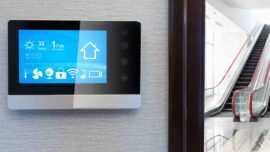
Designing New Build Data Centres: Optimising Cooling Energy Consumption

With the advent of new technologies, particularly Artificial Intelligence (A.I.), the demand for data centres in the GCC region is growing at an unprecedented rate. This surge in demand presents both opportunities and challenges, particularly in the context of the GCC’s goal of achieving Carbon Net Zero by 2050. Among the various aspects of data centre design, optimising cooling energy consumption is crucial for achieving sustainability and operational efficiency.
The Growing Importance of Data Centres
Data centres are the backbone of modern digital infrastructure, supporting everything from cloud computing to AI-driven applications. As businesses and governments increasingly rely on digital solutions, the capacity and efficiency of data centres become critical. According to a recent study by CBRE, the current capacity of data centres in the GCC is set to double over the next two years, reaching over 700 MW. This rapid expansion underscores the need for innovative and sustainable design practices.

Challenges in Cooling Energy Consumption
Cooling systems are a significant component of data centre energy consumption, as servers and other equipment generate substantial heat, which must be dissipated to maintain optimal operating conditions. Inefficient cooling can lead to higher operational costs, increased carbon emissions, and a greater risk of equipment failure. Therefore, optimising cooling energy consumption is essential for both economic and environmental reasons.
The Role of Efficient Layout and Airflow Management
One of the primary strategies for reducing cooling energy consumption is optimising the physical layout and airflow management within the data centre, and particularly the data hall. Properly designed airflow management systems, such as hot and cold aisle containment, can significantly reduce the mixing of hot and cold air. This separation ensures that cooling systems operate more efficiently, reducing the energy required to maintain the desired temperature.
Hot and cold aisle containment involves arranging server racks in alternating rows, with cold air intakes facing one aisle and hot air exhausts facing the other. This configuration prevents hot air from recirculating into the cold air intake, improving the efficiency of the cooling system. Additionally, raised floors and overhead cooling systems can enhance airflow and cooling efficiency.
Energy-Efficient Cooling Systems
Investing in energy-efficient cooling systems is another critical step in optimising cooling energy consumption. Modern cooling technologies, such as precision air conditioning units and economisers, offer substantial energy savings compared to traditional systems. These technologies use advanced controls and variable speed drives to adjust cooling capacity based on real-time demand, ensuring optimal performance without wasting energy.
Economisers, for example, take advantage of favourable outdoor conditions to reduce the load on mechanical cooling systems and by using outside air for cooling when the conditions are suitable, economisers can significantly reduce energy consumption. Liquid cooling systems, which use water or other coolants instead of air, can also offer higher efficiency and lower energy consumption in certain scenarios.
Heat Recovery and Waste Heat Utilisation
Implementing heat recovery solutions can further enhance the sustainability of data centres. Waste heat generated by data centre operations can be repurposed for other applications, such as Hot Water Services (HWS) for nearby buildings or industrial processes. This approach not only reduces the overall energy consumption of the data centre but also provides a secondary benefit by offsetting energy use in other areas.
This integration of data centres with local energy systems creates a symbiotic relationship that enhances overall energy efficiency and sustainability.
Advanced Monitoring and Analytics
Real-time monitoring and analytics are essential tools for optimising cooling energy consumption and by continuously tracking key performance indicators (KPIs) such as temperature, humidity, and energy use, data centre operators can identify inefficiencies and make data-driven decisions to improve performance. Digital twins, which are virtual replicas of physical systems, can provide detailed insights into the behaviour of cooling systems and help predict maintenance needs.
IoT-enabled sensors and advanced analytics platforms can detect anomalies and provide early warnings of potential issues, allowing for proactive maintenance and optimisation. These technologies enable operators to fine-tune cooling systems for maximum efficiency and reliability, reducing both energy consumption and operational costs.
The Importance of Comprehensive Testing and System Optimisation
To ensure that data centres operate at peak efficiency, it’s crucial to focus on several key areas:
Controls: Testing and Optimisation
Efficient control systems are essential for maintaining optimal performance in data centres. This involves not only the initial setup but also ongoing testing and optimisation. Testing the controls for Heating, Ventilation, and Air Conditioning (HVAC), Uninterruptible Power Supply (UPS), and lighting systems ensures that they operate correctly and efficiently. Fine-tuning these controls can lead to significant energy savings and improved overall performance, aligning with the data centre’s energy efficiency goals.
Performance Testing: Ensuring Operational Excellence
Performance testing is critical for verifying that all systems within the data centre function as intended. This includes environmental tests to ensure that temperature, humidity, and air quality levels are maintained within optimal ranges. Integrated system tests assess the compatibility and interaction between various systems, such as power, cooling, and security integrations. Comprehensive performance testing ensures that all components work seamlessly together, enhancing the data centre’s reliability and efficiency.
Power Systems: Ensuring Reliability and Redundancy
Power systems are the lifeline of data centres and must be designed to ensure uninterrupted operation. This includes implementing diverse routing for power supply lines to minimise the risk of outages due to a single point of failure. Reliable emergency and stand-by power supplies, such as generators and UPS systems, provide backup power during outages, ensuring continuous operation. Additionally, energy-efficient lighting and advanced lighting control systems contribute to overall energy savings and operational efficiency.
Impact on Net Zero 50 in the UAE and GCC Region
The push towards sustainability in the GCC region is driven by targets such as Net Zero 50. Achieving these goals requires significant reductions in carbon emissions, with a focus on key sectors like data centres. According to the International Energy Agency, data centres and data transmission networks each account for just 1-1.5 percent of global electricity use. However, to meet Net Zero 2050 targets, emissions from these sectors must drop by half by 2030.
Optimising cooling energy consumption is a critical component of this effort and adopting energy-efficient cooling technologies and practices, data centres can significantly reduce their carbon footprint. The GCC region has already seen promising developments, with leading data centre providers like MORO HUB (DEWA’s digital arm) achieving recognition for their large-scale solar parks and Khazna adopting biofuels for their UAE facilities.
Sustainable Design Practices
Incorporating sustainable design practices into data centre construction is essential for meeting both operational and environmental goals. Sustainable design not only reduces energy consumption but also enhances the resilience and longevity of data centre infrastructure. Key sustainable design practices include:
-
- Renewable Energy Integration: Utilising renewable energy sources such as solar, wind, and biofuels to power data centre operations can significantly reduce carbon emissions. The UAE, for example, has committed over USD 160 billion to renewable energy projects, demonstrating a strong commitment to sustainability.
- Energy-Efficient Building Materials: Using energy-efficient building materials and construction techniques can reduce the overall energy demand of data centres. Insulation, reflective roofing, and energy-efficient windows are examples of materials that can improve energy efficiency.
- Water Conservation: Implementing water-efficient cooling technologies and practices can reduce water consumption, which is particularly important in the arid GCC region. Techniques such as using greywater for cooling and implementing closed-loop cooling systems can minimise water use.
By focusing on these aspects of data centre design and optimisation, you can ensure that your facilities are not only efficient and reliable but also aligned with the broader goals of sustainability and carbon reduction.
Core Emirates: Your Partner in Sustainable Data Centre Design
At Core Emirates, we specialise in optimising data centres with a strong focus on sustainability and energy efficiency. Our comprehensive services form the foundation for developing accurate and insightful digital models. These models help identify opportunities for optimising cooling energy consumption and enhancing overall building performance.
Our expert team leverages innovative technologies and best practices to create tailored solutions that meet the unique needs of our clients. Whether you’re looking to enhance energy efficiency, optimise building performance, or achieve sustainability goals like Net Zero 50, Core Emirates is here to partner with you every step of the way.
Contact Us Today
Ready to optimise the design of your new build data centre and minimise cooling energy consumption? Contact Core Emirates today at info@core-emirates.com or visit our website, https://core-emirates.com/critical-systems-engineering-data-centers/, to learn more about our comprehensive range of services. Let’s work together to build data centres that are efficient, reliable, and sustainable for years to come.





0 comments
Write a comment